HOME / ABOUT SHAW / Amusement Parks
Amusement Parks
Great World and New World
Follow the streams of cars purring east and west, the sweating rickshaw pullers pulling families of two, three or four, mingle with the walking crowd and let yourself be led by them and you eventually come to a huge gateway. Electric words proclaim you are entering
a 'World', a 'Great' and a 'New' world, a world bounded by high fencing, inside which can be found laughter and happiness, and the comedies and tragedies of life.
(Singapore Free Press, Apr 27, 1937)
(Singapore Free Press, Apr 27, 1937)
It was after the Depression that the Shaws diversified their entertainment business into other areas like amusement parks. These were modelled after the ones in Shanghai where they were a massive hit with the local population.

From the mid 30s to the 80s the Shaws operated two highly popular fairgrounds. They were the Great World at Kim Seng Road and New World at Jalan Besar.
The New World had already been operating since 1923 under Ong Boon Tat and Ong Peng Hock, two prominent Baba Merchants. It entertained with boxing, wrestling, variety shows, opera and a small cabaret with Philipino artistes.
Soon after, the Great World was opened by businessman Lim Choon Seng.
Eventually, the Shaws bought out their partner and wholly owned both New
The New World had already been operating since 1923 under Ong Boon Tat and Ong Peng Hock, two prominent Baba Merchants. It entertained with boxing, wrestling, variety shows, opera and a small cabaret with Philipino artistes.
Soon after, the Great World was opened by businessman Lim Choon Seng.
Eventually, the Shaws bought out their partner and wholly owned both New
World and Great World.
The New World, bounded by Serangoon and Kitchener Roads whose population was predominantly the middle and lower strata, started out much more boisterous than Great World. However, both parks had their fair sprinkling of all the races including Europeans and Eurasians.
Without television, and for most people, even radio, going to the amusement parks satisfied their craving for entertainment. Many families went at least once a week.
With admission price of 10 cents, patrons were greeted by joyrides such
The New World, bounded by Serangoon and Kitchener Roads whose population was predominantly the middle and lower strata, started out much more boisterous than Great World. However, both parks had their fair sprinkling of all the races including Europeans and Eurasians.
Without television, and for most people, even radio, going to the amusement parks satisfied their craving for entertainment. Many families went at least once a week.
With admission price of 10 cents, patrons were greeted by joyrides such
as roller coasters as well as the usual fun fair games, ferris wheel, ghost trains, open air dancing, circus and fashion shows. Within the parks, regular contests and lucky draws were also held. In some events, attractive prizes such cars were up for grabs.
Refreshments could easily be found in the parks. Apart from the many excellent hawker stalls, both New World and Great World had formal restaurants serving Cantonese as well as Western cuisine. The Cantonese restaurants were popular venues for wedding dinners and matchmaking among the Chinese. In the Great World, the Black and Normal Cafe was a popular place for the latter.
Refreshments could easily be found in the parks. Apart from the many excellent hawker stalls, both New World and Great World had formal restaurants serving Cantonese as well as Western cuisine. The Cantonese restaurants were popular venues for wedding dinners and matchmaking among the Chinese. In the Great World, the Black and Normal Cafe was a popular place for the latter.

Another big draw were Chinese wayang and Malay opera performances.
Patrons who were willing to view them from the sides could avoid the 10 cents charge for seats within boundaries. Fairground cinemas were
Patrons who were willing to view them from the sides could avoid the 10 cents charge for seats within boundaries. Fairground cinemas were
also immensely popular with the crowds.
They were the Pacific, State and Grand in New World; Sky (top right), Globe (center right), Canton and Atlantic in Great World. In fact, cinemas already existed in the fairgrounds since 1927 'the silent
They were the Pacific, State and Grand in New World; Sky (top right), Globe (center right), Canton and Atlantic in Great World. In fact, cinemas already existed in the fairgrounds since 1927 'the silent
film era', long before the Shaws came in.
By the late 30s, New World had invented itself as the pioneer amusement park in Malaya. Visitors to Singapore like Charlie Chaplin even included it in his itinerary.
By the late 30s, New World had invented itself as the pioneer amusement park in Malaya. Visitors to Singapore like Charlie Chaplin even included it in his itinerary.
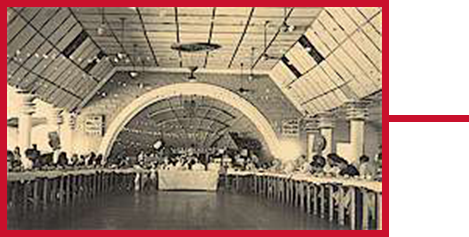
Dance floor of the Great World cabaret, 1947
Arguably the most popular attraction in both New World and Great World were their cabarets. These opened around 7 pm, closing on midnight during the week and 1 am on Saturdays. In the 1930s, admission fee was between 50 cents and one dollar.
On weekends, there were tea dances that cost a dollar for three dances.
On weekends, there were tea dances that cost a dollar for three dances.
Cabaret ballroom dancing was dominated by the waltz, fox-trot, quickstep, tango and rhumba. Big bands like the American Dance Band and D'Souza's entertained crowds in the 1930s with the latest Western tunes.
One of the main draws was the nightly floor shows performance by Shanghainese beauties. These floor
One of the main draws was the nightly floor shows performance by Shanghainese beauties. These floor
shows were patronised by all segments of society but mostly towkays and young Chinese men dressed in Normal European clothes and black leather shoes. Many were regulars and came almost every night. Besides floor shows, customers to the cabaret were entertained by cabaret girls who, at any one time, numbered over 150.
Band of the New World cabaret, 1930s
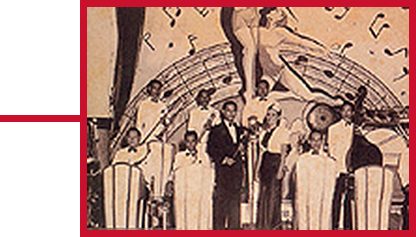
They were predominantly local or Hong Kong Chinese girls but attired in semi-European dresses with provocatively high side-slits. Sometimes, Eurasians, Indians and Filipino girls were also available. The Eurasian girls were especially popular with British soldiers who did not understand the languages the other girls spoke.
Of all the Cabarets, the New World boasted the youngest girls. The cabaret girls were known as taxi-girls because they could be hired for dancing by
Of all the Cabarets, the New World boasted the youngest girls. The cabaret girls were known as taxi-girls because they could be hired for dancing by
anyone with a coupon. These coupons were purchased by single men at the door. Three dances cost one dollar. Out of this, Cabaret girls were generally paid a commission of about 8 cents a dance and each dance is registered on a card.
Popular girls, whose dance cards were always filled, would be promoted by management and allowed to keep all their coupon takings. Others were paid a fixed salary of $25 monthly but only 40% of coupon takings. The girls could even be booked at a rate of $13 an hour, of
Popular girls, whose dance cards were always filled, would be promoted by management and allowed to keep all their coupon takings. Others were paid a fixed salary of $25 monthly but only 40% of coupon takings. The girls could even be booked at a rate of $13 an hour, of
which they kept a fraction as commission. Often, 'booking' meant that the man could date the hostess after the cabaret closed. But with such high booking fees only rich towkays could afford, most men could only engage dance hostesses for a few dances.
The dancing floor in the cabarets were huge. In New World, the dance floor could hold up to 500 twirling couples. Security within the premises were tight and drunks were kept in check by beefy bouncers.
The dancing floor in the cabarets were huge. In New World, the dance floor could hold up to 500 twirling couples. Security within the premises were tight and drunks were kept in check by beefy bouncers.
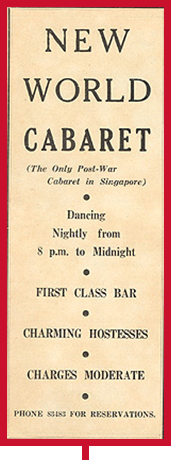
Newspaper advertisement, 1948
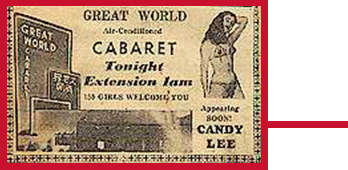
Newspaper advertisement, 1958
Advertisement for wrestling at Great World, 1948
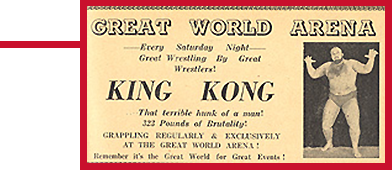
Special events at the cabaret included the annual Song and Band Championships, competitions for the Kronchong-Asli comic titles, Malay film song contests, dance competitions as well as the Annual Malaya Kebaya Queen Competition. In fact, it was the quality of the Shaws cabarets that really put their parks ahead of the competition. The most serious of these came from Lee Geok Engs (Lee Kong Chian's brother)
Happy World (aka Gay World) in Geylang.
utside of the Cabaret, Malay dances such as joget and ronggeng within the parks were held in halls. These were held until 11pm, and catered mainly to Malays and Peranakans. Like the Cabaret, dances with joget girls were paid for in the form of coupons.
Wrestling events also attracted crowds.
utside of the Cabaret, Malay dances such as joget and ronggeng within the parks were held in halls. These were held until 11pm, and catered mainly to Malays and Peranakans. Like the Cabaret, dances with joget girls were paid for in the form of coupons.
Wrestling events also attracted crowds.
The mid-50s saw wrestlers with names such as Ho Wah Peng, Scott, Kumar and Tiger Amat vying for the championship. Boxing was also popular with imported foreign talent thrown in for added excitement.
In September 1934, tragedy struck in the ring of New World. A young boxer from California, Joe Thunderface died during a fight with local champ Frankie Weber.
In September 1934, tragedy struck in the ring of New World. A young boxer from California, Joe Thunderface died during a fight with local champ Frankie Weber.
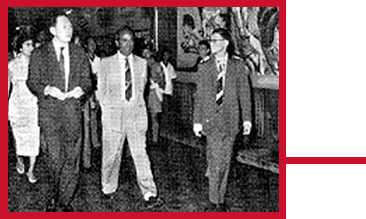
Movie premiere of Diau Charn starring Lin Dai,
Great World, 1958
Prime Minister Lee Kuan Yew, S. Rajaratnam and Shaw Vee Tzan tour the Great World Singapore National Economic Development Fair, 1960
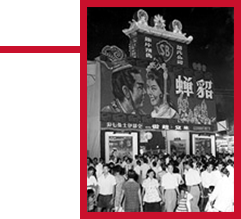
When war spread to Singapore, business at the parks temporarily closed until the Shaws were instructed to re-open the parks under Japanese military control. Night life at the Great World cabaret was restored but New World cabaret could not reopen as it suffered extensive bomb damage.
In fact, the Cabarets, with their bright
In fact, the Cabarets, with their bright
lights were easy target for bombs during Japanese air raids. That was why the Cabarets would turn off all the lights when warnings of a raid came. These moments of blackouts were popular among the men who would indulge in a bit of hanky panky whenever the Caberet plunged into darkness. A name was subsequently coined for these events: 'blackout dances'.
Shortly after 1945, the crowds returned in droves to New and Great World, including the many allied troops stationed in Singapore and Malaya. By 1950, new forms of entertainment sprang up within the parks, including revues and striptease. The first striptease show was in the Fong Fong Cafe in the New World. A famous strip artist of the time was Rose Chan.
More than amusement parks, Great World and New World were also the venue of myriad international trade fairs and industrial exhibitions. For these, stalls were rented by exhibitors to promote and sell their products.
Visitors to the exhibitions could not only enjoy displays of goods from all over the world, but side shows such as jugglers, strong man acts, miniature zoo, acrobatics, 'Miss Trade Fair' beauty contests and joget modern dances.
In 1964, Great World opened its doors for the last time. The Globe of Death featuring death defying motorcyclist stuntmen was one of the final
Visitors to the exhibitions could not only enjoy displays of goods from all over the world, but side shows such as jugglers, strong man acts, miniature zoo, acrobatics, 'Miss Trade Fair' beauty contests and joget modern dances.
In 1964, Great World opened its doors for the last time. The Globe of Death featuring death defying motorcyclist stuntmen was one of the final
attractions there. The 4.6 hectare park was eventually sold off to a developer in 1978. New World lasted until the mid-1980s until it too was sold to a developer. In between management, both its cabaret and Grand Theatre were rented by the Charismatic Church group.
In Malaysia too, the Shaws had a string of amusement parks - Bukit Bintang Amusement Park in KL, City Park in Malacca, Coronation Park in Taiping, Ipoh's Jubilee Amusement Park, Great and New World Park in Penang and Great World in Alor Star. For years, these parks were the favourite weekend getaway for families and crowds looking for fun and excitement.
In Malaysia too, the Shaws had a string of amusement parks - Bukit Bintang Amusement Park in KL, City Park in Malacca, Coronation Park in Taiping, Ipoh's Jubilee Amusement Park, Great and New World Park in Penang and Great World in Alor Star. For years, these parks were the favourite weekend getaway for families and crowds looking for fun and excitement.
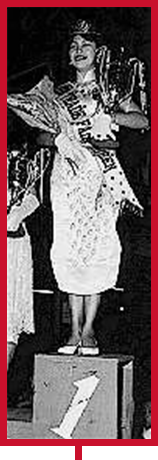
Annie Looi, Miss Trade Fair Queen, Penang, 1960
Next Story